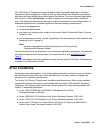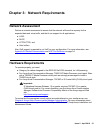
Administration Overview and Requirements
18 Avaya 1600 Series IP Deskphones Administrator Guide
Step 2: DHCP Server to Telephone
The DHCP file server provides information to the telephone, as described in DHCP and File
Servers on page 43. Among other data passed to the telephone is the IP address of the HTTP
or HTTPS server.
Step 3: Telephone and File Server
The 1600 Series IP Telephones can download script files and settings files from either an HTTP
or HTTPS server. These telephones can also download the application files from the HTTP
server. The telephone queries the file server, which transmits a script file to the telephone. This
script file, at a minimum, tells the telephone which application file the telephone must use. The
application file is the software that has the telephony functionality.
The telephone uses the script file to determine if it has the proper application file. If the
telephone determines the proper application file is missing, the telephone requests an
application file download from the HTTP server. The telephone then downloads the file and
conducts some checks to ensure that the file was downloaded properly. If the telephone
determines it already has the proper file, the telephone proceeds as described in the next
paragraph without downloading the application file again.
The telephone checks and loads the application file, then uses the script file to look for a
settings file, if appropriate. The optional settings file can contain settings you have administered
for any or all of the 1600 Series IP Telephones in your network. For more information about this
download process and settings file, see Chapter 6:
Telephone Software and Application Files.
Step 4: Telephone and the Call Server
The call server referred to in this step is the Avaya Media Server.
In this step, the telephone might prompt the user for an extension and password. The telephone
uses that information to exchange a series of messages with the call server. For a new
installation and for full service, the user can enter the telephone extension and password. For a
restart of an existing installation, this information is already stored on the telephone, but the
user might have to confirm the information. The telephone and the call server exchange more
messaging. The expected result is that the telephone is appropriately registered and call server
data such as feature button assignments are downloaded.


















